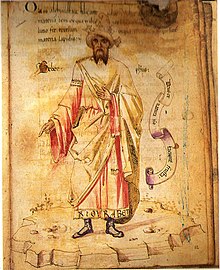Jabir ibn Hayyan
The "Scots" that wis uised in this airticle wis written bi a body that haesna a guid grip on the leid. Please mak this airticle mair better gin ye can. (Dizember 2020) |
Abu Mūsā Jābir ibn Hayyān (Arabic: جابر بن حیان, Persie: جابرحیان, eften gien the nisbahs al-al-Bariqi, al-Azdi, al-Kufi, al-Tusi or al-Sufi; fl. c. 721 – c. 815),[5] kent as Geber an aw, wis a prominent polymath: a chemist an alchemist, astronomer an astrologer, ingineer, geografer, philosopher, physicist, an pharmacist an physician.
| Jabir ibn Hayyan | |
|---|---|
 15t-century European portrait o "Geber", Codici Ashburnhamiani 1166, Biblioteca Medicea Laurenziana, Florence | |
| Teetle | Abu Musa Jabir ibn Hayyan |
| Born | c. 721 AD Tus, Umayyad Caliphate[1] |
| Died | c. 815 AD |
| Ethnicity | Arab[2][3] or Persie[4] |
| Era | Islamic Gowden Age |
| Releegion | Islam |
| Main interest(s) | Alchemy an Chemistry, Astronomy, Astrology, Medicine an Pharmacy, philosophy, Physics, philanthropist |
| Notable wirk(s) | Kitab al-Kimya, Kitab al-Sab'een, Beuk o the Kinrick, Beuk o the Balances , Beuk o Eastren Mercury, etc. |
Influenced bi
| |
Influenced
| |
References
eedit- ↑ Tus, V. Minorsky, The Encyclopaedia of Islam, Vol. X, ed. P.J. Bearman, T. Bianquis, C.E. Bosworth, E. van Donzel and W.P. Heinrichs, (Brill, 2000), 741.
- ↑ Kraus, P. (1962). "Djābir B. Ḥayyān". Encyclopaedia of Islam. 2 (2nd ed.). Brill Academic Publishers. pp. 357–359.
As for Djābir's historic personality, Holmyard has suggested that his father was "a certain Azdī called Hayyan, druggist of Kufa... mentioned... in connection with the political machinations that were used by many people, in the eighth century, finally resulted in the overthrow of the Umayyad dynasty.
- ↑ Holmyard, Eric John, "Introduction" to The Works of Geber, translated by Richard Russell (London: Dent, 1928), p. vii: "Abu Musa Jabir ibn Hayyan, generally known merely as Jabir, was the son of a druggist belonging to the famous South Arabian tribe of Al-Azd. Members of this tribe had settled at the town of Kufa, in Iraq, shortly after the Muhammadan conquest in the seventh century A.D., and it was in Kufa that Hayyan the druggist lived."
- ↑
- William R. Newman, Gehennical Fire: The Lives of George Starkey, an American Alchemist in the Scientific Revolution, Harvard University Press, 1994. p.94: "According to traditional bio-bibliography of Muslims, Jabir ibn Hayyan was a Persian alchemist who lived at some time in the eighth century and wrote a wealth of books on virtually every aspect of natural philosophy"
- William R. Newman, "The Occult and Manifest Among the Alchemists", in F. J. Ragep, Sally P Ragep, Steven John Livesey, Tradition, Transmission, Transformation: Proceedings of Two Conferences on pre-Modern science held at University of Oklahoma, Brill, 1996/1997, p.178: "This language of extracting the hidden nature formed an important lemma for the extensive corpus associated with the Persian alchemist Jabir ibn Hayyan"
- Henry Corbin, "The Voyage and the Messenger: Iran and Philosophy", Translated by Joseph H. Rowe, North Atlantic Books, 1998. p.45: "The Nisba al-Azdin certainly does not necessarily indicate Arab origin. Geber seems to have been a client (mawla) of the Azd tribe established in Kufa"
- Tamara M. Green, "The City of the Moon God: Religious Traditions of Harran (Religions in the Graeco-Roman World)", Brill, 1992. p.177: "His most famous student was the Persian *Jabir ibn Hayyan (b. circa 721 C.E.), under whose name the vast corpus of alchemical writing circulated in the medieval period in both the east and west, although many of the works attributed to Jabir have been demonstrated to be likely product of later Ismaili' tradition."
- David Gordon White, "The Alchemical Body: Siddha Traditions in Medieval India", University of Chicago Press, 1996. p.447
- William R. Newman, Promethean Ambitions: Alchemy and the Quest to Perfect Nature, University of Chicago Press, 2004. p.181: "The corpus ascribed to the eighth-century Persian sage Jabir ibn Hayyan..."
- Wilbur Applebaum, The Scientific revolution and the foundation of modern science, Greenwood Press, 1995. p.44: "The chief source of Arabic alchemy was associated with the name, in its Latinized form, of Geber, an eighth-century Persian."
- Neil Kamil, Fortress of the Soul: Violence, Metaphysics, and Material Life in the Huguenots New World, 1517–1751 (Early America: History, Context, Culture), JHU Press, 2005. p.182: "The ninth-century Persian alchemist Jabir ibn Hayyan, also known as Geber, is accurately called pseudo-Geber since most of the works published under this name in the West were forgeries"
- Aleksandr Sergeevich Povarennykh, Crystal Chemical Classification of Minerals, Plenum Press, 1972, v.1, ISBN 0-306-30348-5, p.4: "The first to give separate consideration to minerals and other inorganic substances were the following: The Persian alchemist Jabir (721–815)..."
- George Sarton, Introduction to the History of Science, Pub. for the Carnegie Institution of Washington, by the Williams & Wilkins Company, 1931, vol.2 pt.1, page 1044: "Was Geber, as the name would imply, the Persian alchemist Jabir ibn Haiyan?"
- Dan Merkur, in The psychoanalytic study of society (eds. Bryce Boyer, et al.), vol. 18, Routledge, ISBN 0-88163-161-2, page 352: "I would note that the Persian alchemist Jabir ibn Hayyan developed the theory that all metals consist of different 'balances' ..."
- Anthony Gross, The Dissolution of the Lancastrian Kingship: Sir John Fortescue and the Crisis of Monarchy in Fifteenth-century England, Paul Watkins, 1996, ISBN 1-871615-90-9, p.19: "Ever since the Seventy Books attributed to the Persian alchemist Jabir Ibn Hayyan had been translated into Latin ...."
- ↑ "Abu Musa Jabir ibn Hayyan". Encyclopædia Britannica Online. Retrieved 11 Februar 2008.
| This Iran-relatit airticle is a stub. Ye can help Wikipaedia bi expandin it. |